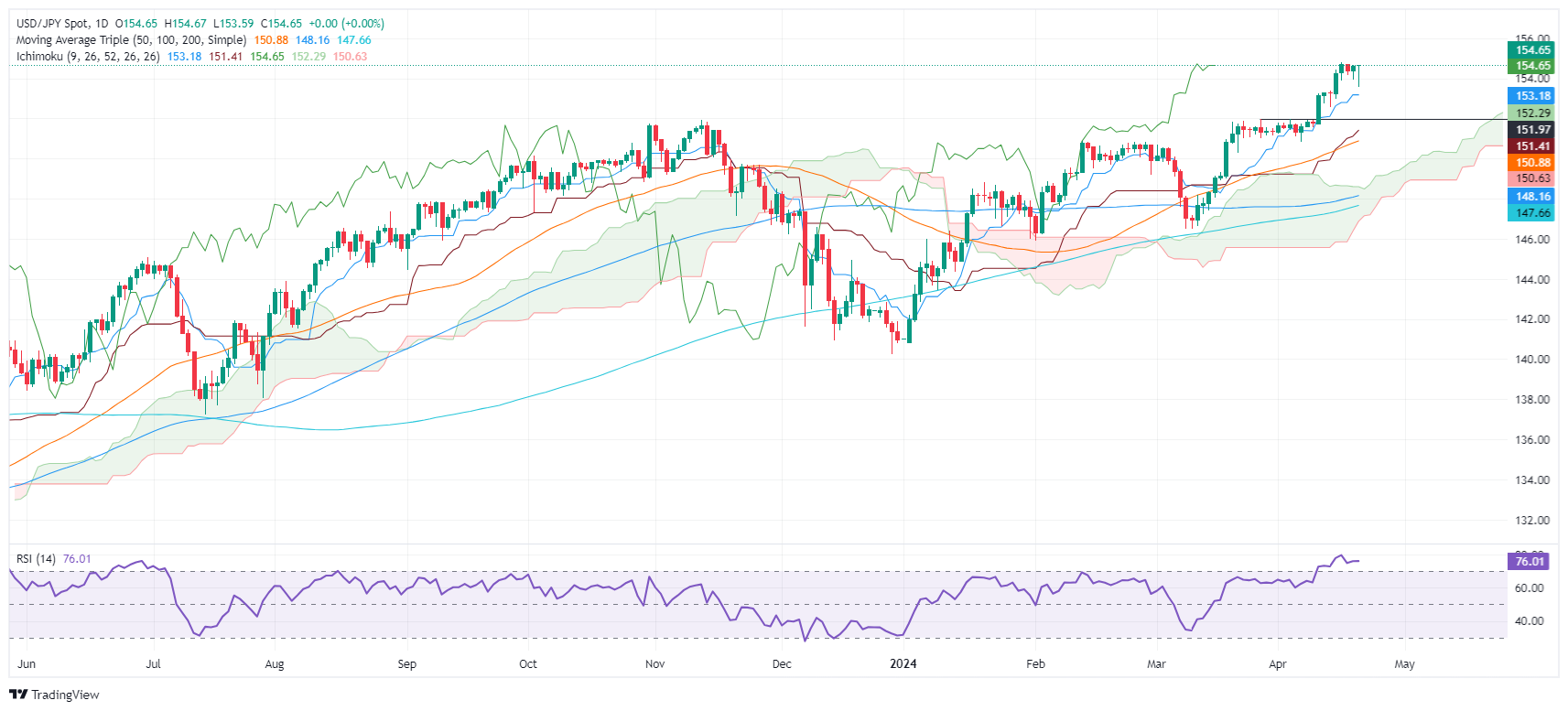USD/JPY Price Analysis: Consolidates around 154.60 on Japanese intervention fears
- USD/JPY recovers after hitting a four-day low, as Tehran’s non-retaliatory stance calms market fears.
- Consolidation near 155.00 under scrutiny, with Japanese officials wary of excessive forex volatility.
- Technical levels to watch: support at Tenkan-Sen 153.18, with further supports at 152.29 and 151.41.
The USD/JPY consolidated at around the 154.60s area on Friday after diving to a four-day low of 153.59, courtesy of heightened geopolitical tensions spurred by the escalation of the Israel-Iran conflict. Nevertheless, Tehran downplayed the attacks, adding they don’t plan to retaliate. That eased off pressure on the financial markets, as witnessed by the correction in the major. The pair trades at 154.62, virtually unchanged.
USD/JPY Price Analysis: Technical outlook
The daily chart portrays the pair consolidated at around peak highs, shy of the 155.00 psychological figure. Japanese authorities jawboning about desirable, orderly moves in the Forex markets keep buyers nervous about pushing the USD/JPY past 155.00. However, once breached, if authorities would not intervene, that would expose the August 1990 high of 155.78, followed by the April 1990 high at 160.32.
Otherwise, if sellers stepped in and pushed the exchange rate below 154.00, that would pave the way for a pullback. The first support would be the Tenkan-Sen at 153.18. Further weakness in the USD/JPY would drive prices past the Senkou Span A at 152.29, followed by the Kijun Sen at 151.41. Up next lies the 50-day moving average (DMA) at 150.89.
USD/JPY Price Action – Daily Chart

Japanese Yen FAQs
The Japanese Yen (JPY) is one of the world’s most traded currencies. Its value is broadly determined by the performance of the Japanese economy, but more specifically by the Bank of Japan’s policy, the differential between Japanese and US bond yields, or risk sentiment among traders, among other factors.
One of the Bank of Japan’s mandates is currency control, so its moves are key for the Yen. The BoJ has directly intervened in currency markets sometimes, generally to lower the value of the Yen, although it refrains from doing it often due to political concerns of its main trading partners. The current BoJ ultra-loose monetary policy, based on massive stimulus to the economy, has caused the Yen to depreciate against its main currency peers. This process has exacerbated more recently due to an increasing policy divergence between the Bank of Japan and other main central banks, which have opted to increase interest rates sharply to fight decades-high levels of inflation.
The BoJ’s stance of sticking to ultra-loose monetary policy has led to a widening policy divergence with other central banks, particularly with the US Federal Reserve. This supports a widening of the differential between the 10-year US and Japanese bonds, which favors the US Dollar against the Japanese Yen.
The Japanese Yen is often seen as a safe-haven investment. This means that in times of market stress, investors are more likely to put their money in the Japanese currency due to its supposed reliability and stability. Turbulent times are likely to strengthen the Yen’s value against other currencies seen as more risky to invest in.
Forex News
Keep up with the financial markets, know what's happening and what is affecting the markets with our latest market updates. Analyze market movers, trends and build your trading strategies accordingly.
